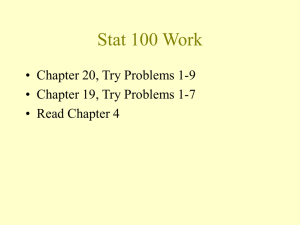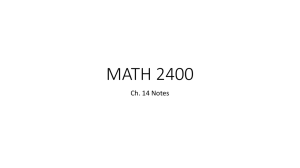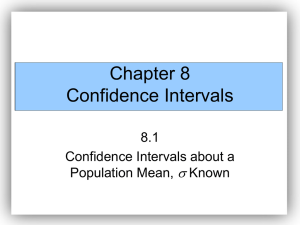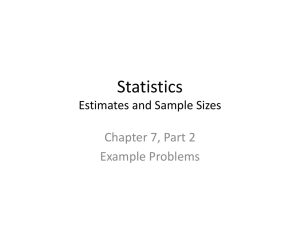Chapter 14
advertisement
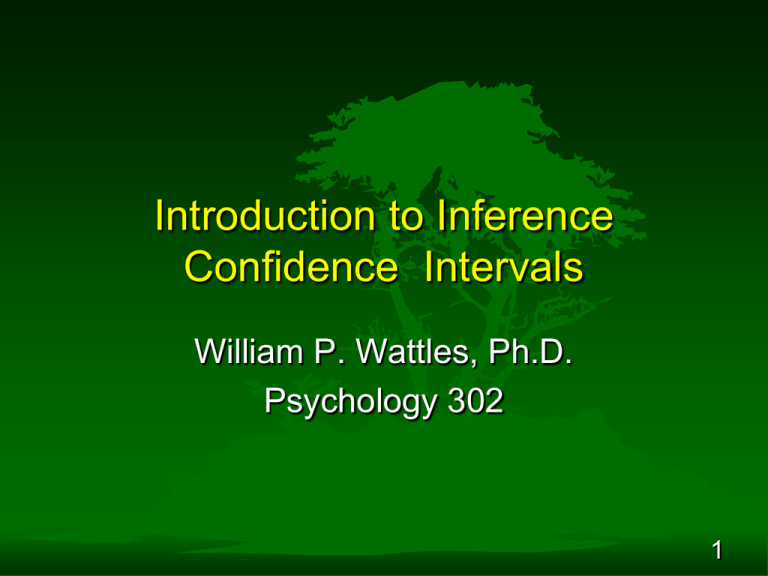
Introduction to Inference Confidence Intervals William P. Wattles, Ph.D. Psychology 302 1 Statistical Inference Provides methods for drawing conclusions about a population from sample data. Population (parameter) Sample (statistic) 2 The problem Sampling Error 3 Sampling error results from chance factors that produce a sample statistic different from the population parameter it represents. 4 5 Inferential statistics How well does the sample statistic predict the unknown population parameter? Population Sample 6 Dealing with sampling error Confidence intervals Hypothesis testing 7 Frequency Distribution Tells what values a variable can take and how often each value occurs 8 Sampling Distribution Tells what values a statistic can take and how often each value occurs. All possible samplings of a given size Less variable than a raw score frequency distribution 9 Confidence interval Point versus interval estimation confidence interval= estimate±margin of error 10 Margin of error example Imagine catering a function where you expect 120 students. 11 Margin of error example Imagine catering a function where you expect 120 students plus or minus 30 What are the upper and lower limits? 12 Margin of error example Imagine catering a function where you expect 120 students plus or minus 30 What are the upper and lower limits? Minimum (lower limit) 90 Maximum (upper limit) 150 13 Obtaining confidence intervals estimate + or - margin of error 14 Upper and Lower limits Bob estimates that Mary weighs 120 pounds “give or take” ten. Calculate the upper and lower limits of his estimate. 15 Upper and Lower limits Bob estimates that Mary weighs 120 pounds “give or take” ten. Calculate the upper and lower limits of his estimate. Upper 130 Lower 110 16 Upper and Lower limits Tom is giving a party and tells the caterer that he expects 80 friends plus or minus 20. Determine the upper and lower limits 17 Upper and Lower limits Tom is giving a party and tells the caterer that he expects 80 friends plus or minus 20. Determine the upper and lower limits Upper 100 Lower 60 18 Upper and Lower limits If something costs $250 plus or minus $25, what is the lower limit, the least you would expect to pay? What is the upper limit or the most you would expect to pay. 19 Upper and Lower limits If something costs $250 plus or minus $25, what is the lower limit, the least you would expect to pay? Upper $275 Lower $225 20 The purpose of a confidence interval is to estimate an unknown parameter and an indication of: 1. of how accurate the estimate is 2. how confident we are that the result is correct. 21 22 Estimatingx with confidence Although the sample mean is a unique number for any particular sample, if you pick a different sample, you will probably get a different sample mean. In fact, you could get many different values for the sample mean, and virtually none of them would actually equal the true population mean, . 23 But the sample distribution is narrower than the population distribution, by a factor of √n. Sample means, n subjects x x n Population, x individual subjects 24 Confidence intervals tell us two things 1. the interval 2. the level of confidence – – C = the confidence interval p=probability 25 Obtaining confidence intervals Confidence interval for a population mean M z σ n 26 Steps to upper limit 1. 2. 3. The Upper limit equals the Mean + Margin of error Margin of error = Z times the standard error (sigma /sqrt of n) Standard Error = std dev/ square root of n 27 Determining critical Z What is the Z for an 80% confidence interval? We need a number that cuts off the upper 10% and the lower 10% Table A look for .90 and .10 Z= -1.28 to cut off lower 10% +1.28 to cut off upper 10% 28 29 Determining Critical values of Z 90% .05 1.645 95% .025 1.96 99% .005 2.576 Critical Values: values that mark off a specified area under the standard normal curve. 30 Homework 31 Confidence intervals Example 14.1 Page 360 Want 95% confidence interval σ =7.5 Mean= 26.8 n=654 32 Confidence intervals Estimate +-Margin of error Estimate 26.8 Margin of error .60 Upper limit – 27.4 Lower Limit – 26.2 33 Obtaining a confidence interval for a sample mean value gives you some idea of how far off you may expect the true population mean to be. Mz σ n 34 Confidence intervals are extremely important in statistics, because whenever you report a sample mean, you need to be able to gauge how precisely it estimates the population mean. 35 Characteristics of confidence intervals The – – – margin of error gets smaller when: Z gets smaller. More confidence=larger interval. (i.e., Only 90% confident versus 95%) sigma gets smaller. Less population variation equals less noise and more accurate prediction n gets larger. 36 Example from cliff notes : Suppose that you want to find out the average weight of all players on the football team. You are select ten players at random and weigh them. The mean weight of the sample of players is 198, so that number is your point estimate. The population standard deviation is σ = 11.50. What is a 90 percent confidence interval for the population weight, if you presume the players' weights are normally distributed? 37 90% confidence interval Area to the right 5% Area between that point and the mean 45% Z value 1.65 5 90 5 38 90% Confidence Interval Another way to express the confidence interval is as the point estimate plus or minus a margin of error; in this case, it is 198 ± 6 pounds. 192-204 39 Confidence Intervals Student Study Times 40 Confidence Intervals Students (269) asked how many hours do you study on a typical weeknight? – sample mean 137 minutes – study times standard deviation is 65 minutes – Create a 99% confidence interval 41 Problem 14.30 Mean Std dev n z std error margin of error lower upper 137 65 269 2.576 3.96312 10.209 126.8 147.2 42 Sampling Distribution Homework 43 Problem 14.54 page 390 Wine odors 44 DMS odor threshold Mean 30.4 Std dev 7 95% conf interval 45 Problem 14.27 Mean 30.4 Std dev 7 n 10 z 1.96 std error 2.213594 margin of error 4.338645 lower 26.06 upper 34.74 46 Caution page 344 The conditions: – Perfect SRS – Population is normal – We know the population standard deviation (σ) These conditions are unrealistic. 47 Parametric statistics Assume raw scores form a normal distribution Assume the data are interval or ratio scores (measurement data) Assume raw scores are randomly drawn Robust refers to accuracy of procedure if one of the assumptions is violated, 48 Random error versus bias The margin of error in a confidence interval covers only random sampling errors. 49 The End 50



